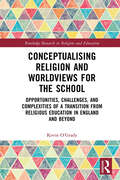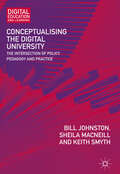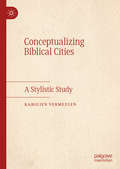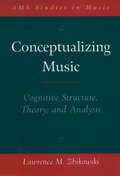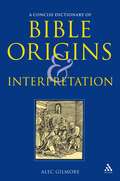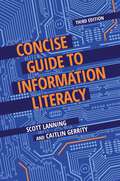- Table View
- List View
Conceptualising Religion and Worldviews for the School: Opportunities, Challenges, and Complexities of a Transition from Religious Education in England and Beyond (Routledge Research in Religion and Education)
by Kevin O'GradyThis timely volume addresses current debates surrounding the transition from the teaching of religious education (RE) to the more holistic subject of Religion and Worldviews (R&W) in England, and posits criteria for best practice among educators in varied settings and in a broader international context. By examining empirical sources, governmental reports, and in particular the 2018 final report from the Commission on Religious Education (CORE), the volume suggests key principles needed to guide the transition and ensure that R&W is effectively integrated into curricula, pedagogy, and teaching resources to meet the needs of all student groups. By effectively conceptualising R&W, the volume gives particular attention to the intersections of the subject with democratic citizenship education, intercultural competence, and religious literacy. This text will benefit researchers, academics, and educators with an interest in religious education and teacher education as well as the philosophy and sociology of education more broadly. Those interested in education policy and politics, as well as citizenship and schooling in the UK, will also benefit from this volume.
Conceptualising Religion and Worldviews for the School: Opportunities, Challenges, and Complexities of a Transition from Religious Education in England and Beyond (Routledge Research in Religion and Education)
by Kevin O'GradyThis timely volume addresses current debates surrounding the transition from the teaching of religious education (RE) to the more holistic subject of Religion and Worldviews (R&W) in England, and posits criteria for best practice among educators in varied settings and in a broader international context. By examining empirical sources, governmental reports, and in particular the 2018 final report from the Commission on Religious Education (CORE), the volume suggests key principles needed to guide the transition and ensure that R&W is effectively integrated into curricula, pedagogy, and teaching resources to meet the needs of all student groups. By effectively conceptualising R&W, the volume gives particular attention to the intersections of the subject with democratic citizenship education, intercultural competence, and religious literacy. This text will benefit researchers, academics, and educators with an interest in religious education and teacher education as well as the philosophy and sociology of education more broadly. Those interested in education policy and politics, as well as citizenship and schooling in the UK, will also benefit from this volume.
Conceptualising the Digital University: The Intersection of Policy, Pedagogy and Practice (Digital Education and Learning)
by Bill Johnston Sheila MacNeill Keith SmythDespite the increasing ubiquity of the term, the concept of the digital university remains diffuse and indeterminate. This book examines what the term 'digital university' should encapsulate and the resulting challenges, possibilities and implications that digital technology and practice brings to higher education. Critiquing the current state of definition of the digital university construct, the authors propose a more holistic, integrated account that acknowledges the inherent diffuseness of the concept. The authors also question the extent to which digital technologies and practices can allow us to re-think the location of universities and curricula; and how they can extend higher education as a public good within the current wider political context. Framed inside a critical pedagogy perspective, this volume debates the role of the university in fostering the learning environments, skills and capabilities needed for critical engagement, active open participation and reflection in the digital age. This pioneering volume will be of interest and value to students and scholars of digital education, as well as policy makers and practitioners.
Conceptualising Women’s Working Lives: Moving the Boundaries of Discourse (Career Development Series #5)
by Wendy PattonTheoretical work on the career development of women has travelled a journey from critique to creation. Early work responded to and criticised a literature that focused on theorising male roles in a workplace that was conceptualised as providing vertical career paths primarily for middle class males. More recently theorists are creating new constructions and frameworks to enable a more holistic understanding of career, applicable to both women and men. These constructions include broadening the discussion from women’s careers to women’s working lives. This is the fifth book in the Sense Publishers Career Development Series. It features the vibrant work of contributors from around the world writing in the field of women’s working lives. It emphasises the need to explore theoretical connections and understandings in order to facilitate a more holistic and inclusive understanding of women’s working lives. The writers in the current volume acknowledge the changing roles of women, in both public and private spheres. Women’s roles in paid work are changing both in their nature and type of engagement. In addition, with an ageing population, women’s roles in care work are increasingly being extended from child care to aged care. This book provides a history of theorising about women's careers, in addition to presenting a focus on current empirical and theoretical work which contributes to understandings of women's working lives. It’s contributions both map the current discourse and challenge future work to extend the boundaries of that discourse.
Conceptualizations of Blackness in Educational Research (Indigenous and Decolonizing Studies in Education)
by Rosalind Hampton Sefanit Habtom Joanna L. WilliamsConceptualizations of Blackness in Education engages the specific junction of educational research and multiple theorizations of Blackness. In this volume, authors narrate how they have come to conceptualize Blackness through reading, writing, research, training, and practice. The contributors reflect a range of personal and political perspectives and experiences, disciplinary roots, and career stages. The stories in each chapter are intended to encourage more theoretically reflexive and vulnerable conversations among scholars of Black Studies in Education committed to reducing inequality in the lives of Black youth. They are not merely stories about theory; the stories are theories themselves.
Conceptualizations of Blackness in Educational Research (Indigenous and Decolonizing Studies in Education)
by Rosalind Hampton Sefanit Habtom Joanna L. WilliamsConceptualizations of Blackness in Education engages the specific junction of educational research and multiple theorizations of Blackness. In this volume, authors narrate how they have come to conceptualize Blackness through reading, writing, research, training, and practice. The contributors reflect a range of personal and political perspectives and experiences, disciplinary roots, and career stages. The stories in each chapter are intended to encourage more theoretically reflexive and vulnerable conversations among scholars of Black Studies in Education committed to reducing inequality in the lives of Black youth. They are not merely stories about theory; the stories are theories themselves.
Conceptualizing and Contextualizing Higher Education with Chinese Characteristics: Ontological and Epistemological Dimensions (Perspectives on Rethinking and Reforming Education)
by Jian Li Xudong ZhuThis book provides a fresh and unique overview of the modernization and internationalization of Chinese higher education, focusing on Chinese higher education from 1949 to 2018. It presents the Ontological Positivism Model (Conceptualization-Explicit-Formal-Share), concentrating on concepts of Chinese higher education.The book is intended for scholars and researchers in the field of comparative higher education, administrators and stakeholders in education management and graduate students majoring in higher education.
Conceptualizing and Innovating Education and Work with Networked Learning (Research in Networked Learning)
by Nina Bonderup Dohn Jens Jørgen Hansen Stig Børsen Hansen Thomas Ryberg Maarten De LaatThe chapters in this book build upon selected research papers from the 12th International Networked Learning Conference 2020, hosted by University of Southern Denmark, Kolding. The selected chapters were chosen as cutting-edge research on networked learning which reflected focal discussion points during the conference such as: new demands on teachers in online and hybrid learning environments; organization of professional learning to meet and reflect on these demands; support of educators and students’ digital literacy; the interaction of human and technological agents in networked learning; and the development of new of networked learning designs to critically and creatively make use of technological possibilities. The book is organized into three main sections: 1) Professional learning, 2) Learning networks’ development and use of digital resources, and 3) Innovating Networked Learning. Preceding the three main sections is a first chapter, which presents a discourse analysis of how the term “networked learning” has been used in the papers at previous Networked Learning Conferences. The concluding chapter draws out perspectives from the chapters and point to emerging issues within the field of networked learning.
Conceptualizing Biblical Cities: A Stylistic Study
by Karolien VermeulenThis book offers a comprehensive treatment of the city image in the Hebrew Bible, with specific attention to stylistics. By engaging with spatial theory (Lefebvre 1974, Soja 1996), the author develops a new framework to analyse the concept of ‘city’, arguing that a set of conceptual images defines the Biblical Hebrew city, each of them constructed using the same linguistic toolkit. Contrary to previous studies, the book shows that biblical cities are not necessarily evil or female. In addition, there is no substantial difference between the metaphorical images used for Jerusalem and those used for other cities. This book will be of interest to students and scholars of stylistics, urban studies, critical-spatial theory and biblical studies (especially Biblical Hebrew).
Conceptualizing Environmental Citizenship for 21st Century Education (Environmental Discourses in Science Education #4)
by Pedro Reis Andreas Ch. Hadjichambis Demetra Paraskeva-Hadjichambi Jan Činčera Jelle Boeve-de Pauw Niklas Gericke Marie-Christine KnippelsThis Open Access book is about the development of a common understanding of environmental citizenship. It conceptualizes and frames environmental citizenship taking an educational perspective. Organized in four complementary parts, the book first explains the political, economic and societal dimensions of the concept. Next, it examines environmental citizenship as a psychological concept with a specific focus on knowledge, values, beliefs and attitudes. It then explores environmental citizenship within the context of environmental education and education for sustainability. It elaborates responsible environmental behaviour, youth activism and education for sustainability through the lens of environmental citizenship. Finally, it discusses the concept within the context of different educational levels, such as primary and secondary education in formal and non-formal settings. Environmental citizenship is a key factor in sustainability, green and cycle economy, and low-carbon society, and an important aspect in addressing global environmental problems. It has been an influential concept in many different arenas such as economy, policy, philosophy, and organizational marketing. In the field of education, the concept could be better exploited and established, however. Education and, especially, environmental discourses in science education have a great deal to contribute to the adoption and promotion of environmental citizenship.
Conceptualizing Music: Cognitive Structure, Theory, and Analysis (AMS Studies in Music)
by Lawrence M. ZbikowskiThis book shows how recent work in cognitive science, especially that developed by cognitive linguists and cognitive psychologists, can be used to explain how we understand music. The book focuses on three cognitive processes--categorization, cross-domain mapping, and the use of conceptual models--and explores the part these play in theories of musical organization. The first part of the book provides a detailed overview of the relevant work in cognitive science, framed around specific musical examples. The second part brings this perspective to bear on a number of issues with which music scholarship has often been occupied, including the emergence of musical syntax and its relationship to musical semiosis, the problem of musical ontology, the relationship between words and music in songs, and conceptions of musical form and musical hierarchy. The book will be of interest to music theorists, musicologists, and ethnomusicologists, as well as those with a professional or avocational interest in the application of work in cognitive science to humanistic principles.
Conceptualizing Music: Cognitive Structure, Theory, and Analysis (AMS Studies in Music)
by Lawrence M. ZbikowskiThis book shows how recent work in cognitive science, especially that developed by cognitive linguists and cognitive psychologists, can be used to explain how we understand music. The book focuses on three cognitive processes--categorization, cross-domain mapping, and the use of conceptual models--and explores the part these play in theories of musical organization. The first part of the book provides a detailed overview of the relevant work in cognitive science, framed around specific musical examples. The second part brings this perspective to bear on a number of issues with which music scholarship has often been occupied, including the emergence of musical syntax and its relationship to musical semiosis, the problem of musical ontology, the relationship between words and music in songs, and conceptions of musical form and musical hierarchy. The book will be of interest to music theorists, musicologists, and ethnomusicologists, as well as those with a professional or avocational interest in the application of work in cognitive science to humanistic principles.
Conceptualizing Soft Power of Higher Education: Globalization and Universities in China and the World (Perspectives on Rethinking and Reforming Education)
by Jian LiThis book examines the globalization trends in higher education from an international political science perspective, using Nye’s theory of soft power to explore the rationale behind it. It focuses on conceptualizing the Soft Power Conversion Model of Higher Education, which is embedded in the globalization of higher education, and analyzes the globalization of Chinese higher education reform.Also, this book provides innovative and unique viewpoints on conceptualizing and mapping the globalization and internationalization of higher education, especially for current Chinese higher education (1949-2016). It discusses and illustrates cutting-edge concepts of global higher education, such as global learning, global competency, and global citizenship and refines them in the conceptualized soft power conversion model of higher education.This book reports on and enriches the theoretical concept of global education, and provides practical insights into global learning, global citizenship and global competency for Chinese undergraduate students.
Concerning the Nations: Essays on the Oracles Against the Nations in Isaiah, Jeremiah and Ezekiel (The Library of Hebrew Bible/Old Testament Studies)
by Andrew Mein Else K. Holt Hyun Chul KimIsaiah, Jeremiah, and Ezekiel share much in common. They address the pivotal times and topics associated with the last stages of the monarchical history of Israel, and with the development of new forms of communal and religious life through exile and beyond. One important structural component of all three books is a substantial section which concerns itself with a range of foreign nations, commonly called the “Oracles against the Nations”, which form the focus of this book. These chapters together present the most up-to-date scholarship on the oracles - an oft-neglected but significant area in the study of the prophetic literature. The particular characteristics of Isaiah, Jeremiah (both Masoretic Text and Septuagint versions), and Ezekiel, are discussed showcasing the unique issues pertinent to each book and the diverse methods used to address them. These evident differences aside, the Oracles Against the Nations are employed as a springboard in order to begin the work of tracing similarities between the texts. By focusing on these unique yet common sections, a range of interrelated themes and issues of both content and method become noticeable: for example, though not exhaustively, pattern, structure, language, comparative history, archaeology, sociology, politics, literature, imagery, theme, theology, and hermeneutical issues related to today's context. As a result this collection presents a range of cutting-edge approaches on these key prophetic books, and will provide a basis for further comparative study and reflection.
Concise Clinical Embryology: an Integrated, Case-Based Approach
by Mark G. Torchia T. V. N. PersaudWritten by the authors of the renowned embryology textbooks The Developing Human and Before We Are Born, Concise Clinical Embryology: An Integrated, Case-Based Approach offers essential, high-yield information and high-quality clinical cases to illustrate key principles of embryology and their relevance to everyday practice. Ideally tailored to the needs of today's medical students and medical courses, this concise text clearly explains how embryology relates to other medical disciplines and its importance in safe, effective clinical practice. Abundant illustrations throughout help you grasp highly visual concepts quickly and easily. - Provides easily digestible, clinically oriented coverage of human development, establishing key principles in a week-by-week, stage-by-stage approach, before moving on to fetal organ development by body system. - Includes clinical cases and follow-up questions in each chapter that help relate key principles to everyday practice, aid in problem-based learning, and offer review for exam preparation. - Covers the latest advances in embryology, including normal and abnormal embryogenesis, causes of birth defects, and the role of genes in human development. - Contains superb illustrations from cover to cover, including diagnostic images, full color figures, histology, and more. - Summarizes molecular biology highlights throughout the text.
The Concise Companion to Language Assessment
by Antony John KunnanThe Concise Companion to Language Assessment provides a state-of-the-art overview of the crucial areas of language assessment, teaching, and learning. Edited by one of the foremost scholars in the field, The Concise Companion combines newly commissioned articles on innovations in assessment with a selection of chapters from The Companion to Language Assessment, the landmark four-volume reference work first published in 2013. Presented in eight themes, The Concise Companion addresses a broad range of language assessment methods, issues, and contexts. Forty-five chapters cover assessment conceptualization, development, research, and policy, as well as recent changes in language assessment technology, learning-oriented assessment, teacher-based assessment, teacher assessment literacy, plurilingual assessment, assessment for immigration, and more. Exploring the past, present, and future possibilities of the dynamic field, The Concise Companion to Language Assessment: Contains dedicated chapters on listening, speaking, reading writing, vocabulary, pronunciation, intercultural competence, and other language skills Describes fundamental assessment design and scoring guidelines, as well as advanced concepts in scenario-based assessment and automated performance scoring Provides insights on different assessment environments, such as classrooms, universities, employment, immigration, and healthcare Covers various qualitative and quantitative research methods, including introspective methods, classical reliability, and structural equation modeling Discusses the impacts of colonialism and discrimination on the history of language assessment Explores the use of AI in writing evaluation, plagiarism and cheating detection, and other assessment contexts Sure to become a standard text for the next generation of applied linguistics students, The Concise Companion to Language Assessment is an invaluable textbook for undergraduate and graduate courses in applied linguistics, language assessment, TESOL, second language acquisition, and language policy.
The Concise Companion to Language Assessment
by Antony John KunnanThe Concise Companion to Language Assessment provides a state-of-the-art overview of the crucial areas of language assessment, teaching, and learning. Edited by one of the foremost scholars in the field, The Concise Companion combines newly commissioned articles on innovations in assessment with a selection of chapters from The Companion to Language Assessment, the landmark four-volume reference work first published in 2013. Presented in eight themes, The Concise Companion addresses a broad range of language assessment methods, issues, and contexts. Forty-five chapters cover assessment conceptualization, development, research, and policy, as well as recent changes in language assessment technology, learning-oriented assessment, teacher-based assessment, teacher assessment literacy, plurilingual assessment, assessment for immigration, and more. Exploring the past, present, and future possibilities of the dynamic field, The Concise Companion to Language Assessment: Contains dedicated chapters on listening, speaking, reading writing, vocabulary, pronunciation, intercultural competence, and other language skills Describes fundamental assessment design and scoring guidelines, as well as advanced concepts in scenario-based assessment and automated performance scoring Provides insights on different assessment environments, such as classrooms, universities, employment, immigration, and healthcare Covers various qualitative and quantitative research methods, including introspective methods, classical reliability, and structural equation modeling Discusses the impacts of colonialism and discrimination on the history of language assessment Explores the use of AI in writing evaluation, plagiarism and cheating detection, and other assessment contexts Sure to become a standard text for the next generation of applied linguistics students, The Concise Companion to Language Assessment is an invaluable textbook for undergraduate and graduate courses in applied linguistics, language assessment, TESOL, second language acquisition, and language policy.
A Concise Dictionary of Bible Origins and Interpretation
by Alec GilmoreConcise, convenient and comprehensive: this handy dictionary will inform and enlighten all who want to understand how the Bible came together, the history of the various texts behind it, the versions in which it has appeared, the process of editing and compilation, and the different methods of interpretation that have developed over the centuries. Much of this material can be found in larger reference works and commentaries, but most students and lay people find that most of these books are written by scholars for scholars, which means the reader can feel bogged down in too much technical detail. Informed by the latest advances in biblical scholarship, this handy dictionary provides the reader with concise, manageable information on all the key issues and topics. It will be especially helpful to students of religion and related subjects, as well as to religious educators in schools, colleges and churches of all denominations.
Concise Encyclopedia of Special Education: A Reference for the Education of the Handicapped and Other Exceptional Children and Adults
by Cecil R. Reynolds Elaine Fletcher-JanzenThe Concise Encyclopedia of Special Education, Second Edition is a comprehensive resource for those working in the fields of special education research and practice. Featuring reviews of assessment instruments and teaching approaches, legal issues, overviews of specific learning disabilities, dozens of biographies, and more, this complete desk reference is an indispensable guide for professionals, academics, and students alike. Named an American Library Association Top 25 Reference of the Year in its First Edition, The Concise Encyclopedia serves as an important reference for the education of handicapped and other exceptional children. Written and edited by highly regarded and respected experts in the fields of special education and psychology, this authoritative resource guide provides a reference base for educators as well as professionals in the areas of psychology, neuropsychology, medicine, health care, social work and law. Additionally, this acclaimed reference work is essential for administrators, psychologists, diagnosticians, and school counselors, as well as parents of the handicapped themselves. What's new in this edition Comprehensive coverage of new legislation such as Individuals with Disabilities Act (IDEA) and the Americans with Disabilities Act Cultural competence in Special Education, including new material on culturally/linguistically diverse students Many new entries including notable biographies, new service delivery systems, special education laws, new assessment instruments, cross-cultural issues, neuropsychology, and use of the Internet in research and service delivery. Some of the topics covered Academic assessment Achievement tests Addictions Bilingual education Child and adolescent behavior management Counseling with individuals and families with disabilities Early childhood education Gifted education Intelligence tests Mathematics disabilities Psychoeducational methods Rehabilitation Socioeconomic status Special education parent and student rights Traumatic brain injury
The Concise Focal Encyclopedia of Photography: From the First Photo on Paper to the Digital Revolution
by Michael R. PeresDefining photography is impossible. Revealing it is another matter, and that's what The Concise Focal Encyclopedia of Photography does,with each turn of the page.History: The technical origins and evolution of photography are half of the story. The other half consists of the ways that cultural forces have transformed photography into a constellation of practices more diverse than any other mode of representation. Photographers can tell a more in-depth story through a photo like Dorothea Lange's "Migrant Mother" than a journalist ever could with the written word alone.Major themes and practitioners: Over 25 entries, many with supporting illustrations,examine the figures, trends, and ideas that have contributed most heavily to the history and current state of photography.Contemporary issues: The issues influencing photography today are more complex than at any other time in its history. Questions of ethics, desire, perception, digitization, and commercialization all vie for attention. Hear what the experts have to say about crucialissues such as whether or not the images we take today will last the test of time, and if so, how?When material is covered this skillfully, "concise" is no compromise. The Concise Focal Encyclopedia of Photography is packed with useful information, compellingideas, and - best of all - pure pleasure.
The Concise Focal Encyclopedia of Photography: From the First Photo on Paper to the Digital Revolution
by Michael R. Peres Mark Osterman Grant B. R Omer Nancy M. Stuart J. Tomas LopezDefining photography is impossible. Revealing it is another matter, and that's what The Concise Focal Encyclopedia of Photography does,with each turn of the page.History: The technical origins and evolution of photography are half of the story. The other half consists of the ways that cultural forces have transformed photography into a constellation of practices more diverse than any other mode of representation. Photographers can tell a more in-depth story through a photo like Dorothea Lange's "Migrant Mother" than a journalist ever could with the written word alone.Major themes and practitioners: Over 25 entries, many with supporting illustrations,examine the figures, trends, and ideas that have contributed most heavily to the history and current state of photography.Contemporary issues: The issues influencing photography today are more complex than at any other time in its history. Questions of ethics, desire, perception, digitization, and commercialization all vie for attention. Hear what the experts have to say about crucialissues such as whether or not the images we take today will last the test of time, and if so, how?When material is covered this skillfully, "concise" is no compromise. The Concise Focal Encyclopedia of Photography is packed with useful information, compellingideas, and - best of all - pure pleasure.
A Concise Guide to Improving Student Learning: Six Evidence-Based Principles and How to Apply Them
by Diane Cummings Persellin Mary Blythe DanielsThis concise guidebook is intended for faculty who are interested in engaging their students and developing deep and lasting learning, but do not have the time to immerse themselves in the scholarship of teaching and learning. Acknowledging the growing body of peer-reviewed literature on practices that can dramatically impact teaching, this intentionally brief book:* Summarizes recent research on six of the most compelling principles in learning and teaching* Describes their application to the college classroom* Presents teaching strategies that are based on pragmatic practices* Provides annotated bibliographies and important citations for faculty who want to explore these topics further This guidebook begins with an overview of how we learn, covering such topics such as the distinction between expert and novice learners, memory, prior learning, and metacognition. The body of the book is divided into three main sections each of which includes teaching principles, applications, and related strategies – most of which can be implemented without extensive preparation.The applications sections present examples of practice across a diverse range of disciplines including the sciences, humanities, arts, and pre-professional programs. This book provides a foundation for the reader explore these approaches and methods in his or her teaching.
A Concise Guide to Improving Student Learning: Six Evidence-Based Principles and How to Apply Them
by Diane Cummings Persellin Mary Blythe DanielsThis concise guidebook is intended for faculty who are interested in engaging their students and developing deep and lasting learning, but do not have the time to immerse themselves in the scholarship of teaching and learning. Acknowledging the growing body of peer-reviewed literature on practices that can dramatically impact teaching, this intentionally brief book:* Summarizes recent research on six of the most compelling principles in learning and teaching* Describes their application to the college classroom* Presents teaching strategies that are based on pragmatic practices* Provides annotated bibliographies and important citations for faculty who want to explore these topics further This guidebook begins with an overview of how we learn, covering such topics such as the distinction between expert and novice learners, memory, prior learning, and metacognition. The body of the book is divided into three main sections each of which includes teaching principles, applications, and related strategies – most of which can be implemented without extensive preparation.The applications sections present examples of practice across a diverse range of disciplines including the sciences, humanities, arts, and pre-professional programs. This book provides a foundation for the reader explore these approaches and methods in his or her teaching.
Concise Guide to Information Literacy
by Scott LanningThis concise but information-packed text helps high school students in upper grade levels and lower division college and university students quickly master the basics of information literacy.A student's textbook and an instructional reference for educators: the second edition of Concise Guide to Information Literacy is both. It teaches students what information literacy is and why it is an important skill to develop—for their schoolwork as well as for success in life outside of school. The guide covers major areas in the information literacy process, including locating, evaluating, and applying information successfully. It also gives professors, teachers, and librarians a flexible text that can serve as the basis of a course in information literacy or research skills, a basic research guide for any information literacy course, or a supplemental text.This second edition has been reorganized for greater ease of use based on the information literacy models consulted. All chapters have been fully updated and now include extended coverage of the topics that appeared in the first edition; additionally, a new chapter on managing information has been added.
Concise Guide to Information Literacy
by Scott Lanning Caitlin GerrityThis flexible text can serve as the basis of a course in information literacy or as a supplemental text or basic research guide in any course.Both a students' textbook and an instructional reference for educators, this brief but information-rich text teaches students what information literacy is and why it's such an important skill to develop. Authors Scott Lanning and Caitlin Gerrity concentrate on developing skills and behaviors that positively impact the information literacy process. They teach such skills as evaluating and using information and behaviors like exploring, analyzing, and creating.Updated to incorporate the new AASL standards, this third edition of Concise Guide to Information Literacy includes new information on the value of curiosity and choice in the research process, offers a new model of the research process (the Reflective Inquiry Model), and updates the Decision Points Information Seeking Model that describes how student researchers choose to use the information they've found. This book has proven to be invaluable for high school and college students learning about information literacy and librarians and teachers in upper high school and community college settings.
